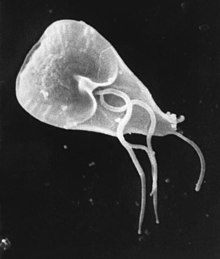
Back جياردية معوية Arabic جيارديه معويه ARZ Bağırsaq lyambliyası Azerbaijani Giardia lamblia Catalan گیاردیا لامبلیا CKB Lamblie střevní Czech Giardia intestinalis German Giàrdia làmblia EML Giardia lamblia Spanish Giardia lamblia Estonian
| Giardia duodenalis | |
|---|---|

| |
| Giardia lamblia cell, SEM | |
| Scientific classification | |
| Domain: | Eukaryota |
| Phylum: | Metamonada |
| Order: | Diplomonadida |
| Family: | Hexamitidae |
| Genus: | Giardia |
| Species: | G. duodenalis
|
| Binomial name | |
| Giardia duodenalis Stiles, 1902
| |
| Synonyms | |
| |
Giardia duodenalis, also known as Giardia intestinalis and Giardia lamblia, is a flagellated parasitic protozoan microorganism of the genus Giardia that colonizes the small intestine, causing a diarrheal condition known as giardiasis.[1][2][3] The parasite attaches to the intestinal epithelium by an adhesive disc or sucker, and reproduces via binary fission.[4] Giardiasis does not spread to other parts of the gastrointestinal tract, but remains confined to the lumen of the small intestine.[5] The microorganism has an outer membrane that makes it possible to survive even when outside of its host, and which can render it tolerant to certain disinfectants. Giardia trophozoites are anaerobic, and absorb their nutrients from the intestinal lumen. If the organism is stained, its characteristic pattern resembles the familiar "smiley face" symbol.[6]
Chief pathways of human infection include ingestion of untreated drinking water (which is the most common method of transmission for this parasite),[3] food, soil contaminated with human feces, and sewage, a phenomenon particularly common in many developing countries.[7][3] Contamination of natural waters also occurs in watersheds where intensive grazing occurs.
Giardia infections occur worldwide. It is the most commonly identified intestinal parasite among children in day-care centers, hikers, immunocompromised adults and their family members in the United States and Canada. About 20,000 cases per year in the United States are reported.[8]
- ^ Simner PJ, Kraft CS (January 2017). "Medical Parasitology Taxonomy Update: January 2012 to December 2015". Journal of Clinical Microbiology. 55 (1): 43–47. doi:10.1128/JCM.01020-16. PMC 5228259. PMID 27440818.
- ^ Rumsey P, Waseem M (4 July 2023). Giardia Lamblia Enteritis. Treasure Island (FL): StatPearls Publishing. PMID 30285390. Retrieved 12 January 2024.
- ^ a b c "Giardia | Parasites | CDC". www.cdc.gov. 24 June 2019. Retrieved 7 April 2020.
- ^ Oxford textbook of Medicine. Vol. 1 (4 ed.). Oxford University Press. 2003. pp. 759–760. ISBN 978-0-19-262922-7.
- ^ Harrison's Internal Medicine, Harrison's Online Chapter 199 Protozoal intestinal infections and trochomoniasis
- ^ DeMay, Richard M. (1999). Practical principles of cytopathology. University of Michigan: American Society for Clinical Pathology. p. 88. ISBN 978-0-89189-437-7.
- ^ Hogan CM (2010). "Water pollution". In McGinley M, Cleveland C (eds.). Encyclopedia of Earth. Washington DC: National Council for Science and the Environment.
- ^ "Pathogen Safety Data Sheet: Infectious Substances – Giardia lamblia". Canada. Public Health Agency of Canada. 30 April 2012. Retrieved 14 April 2018.
© MMXXIII Rich X Search. We shall prevail. All rights reserved. Rich X Search